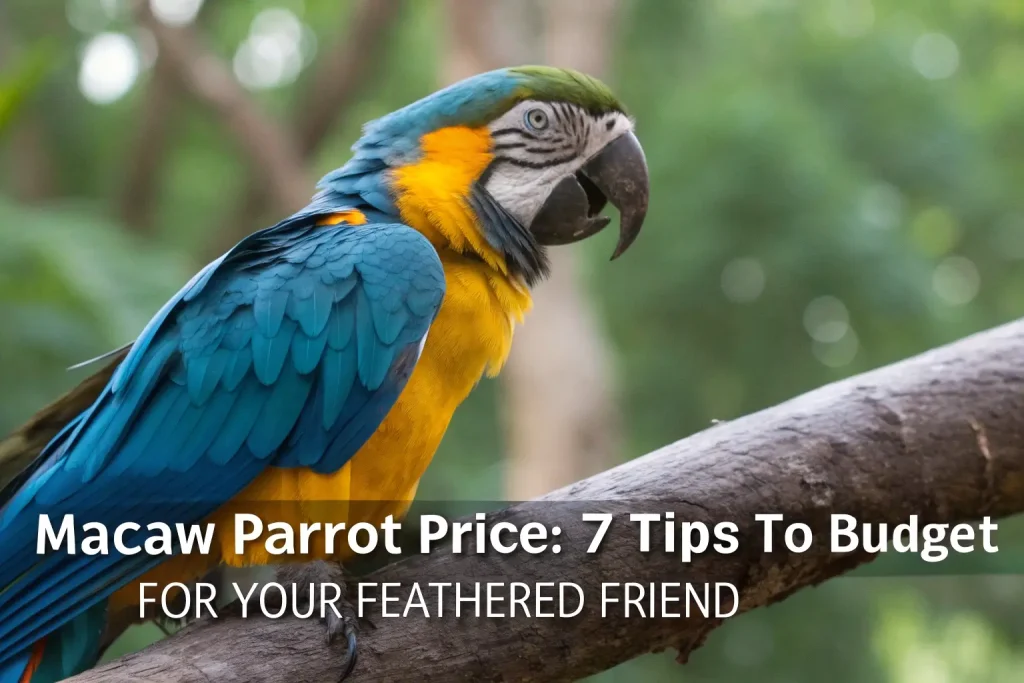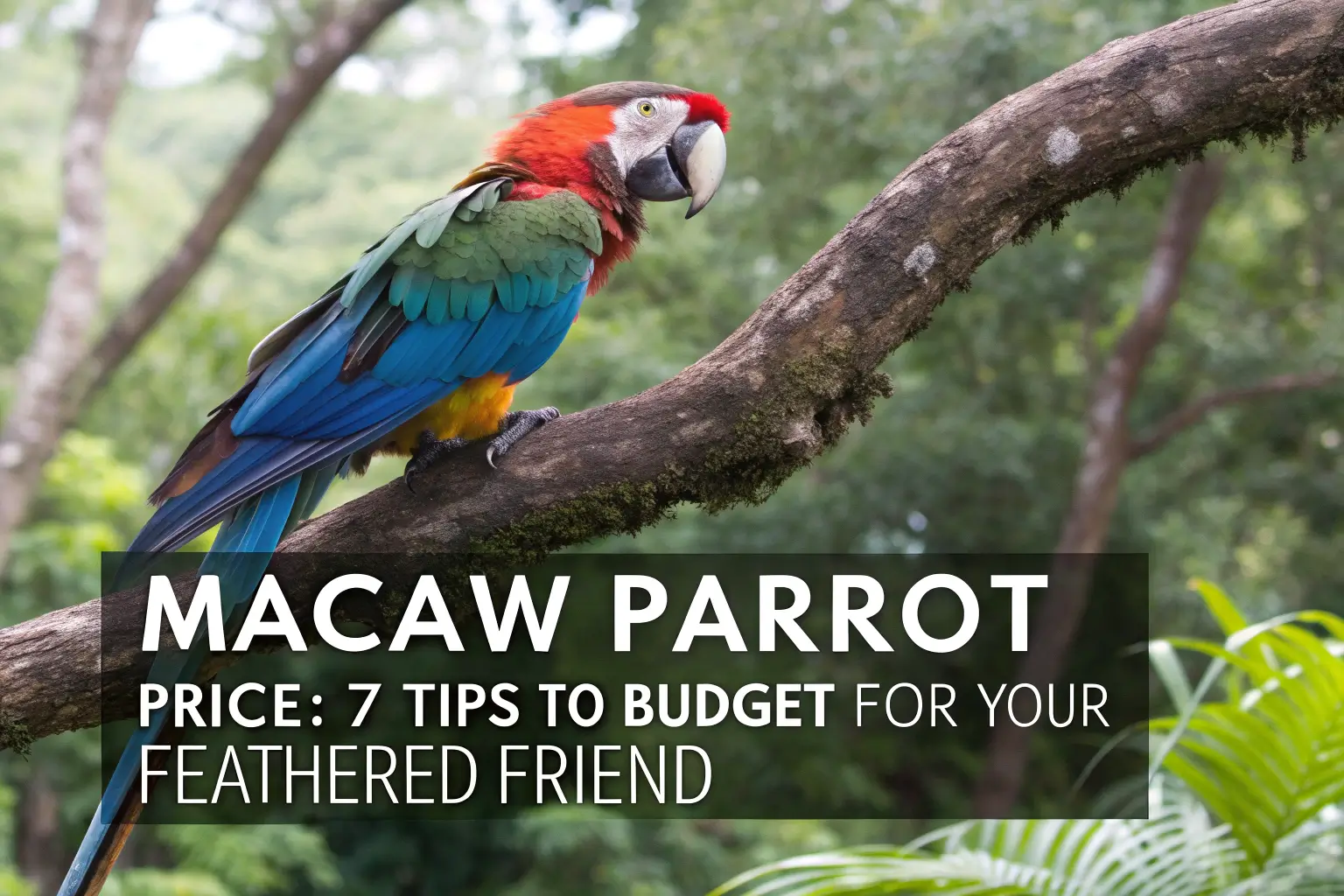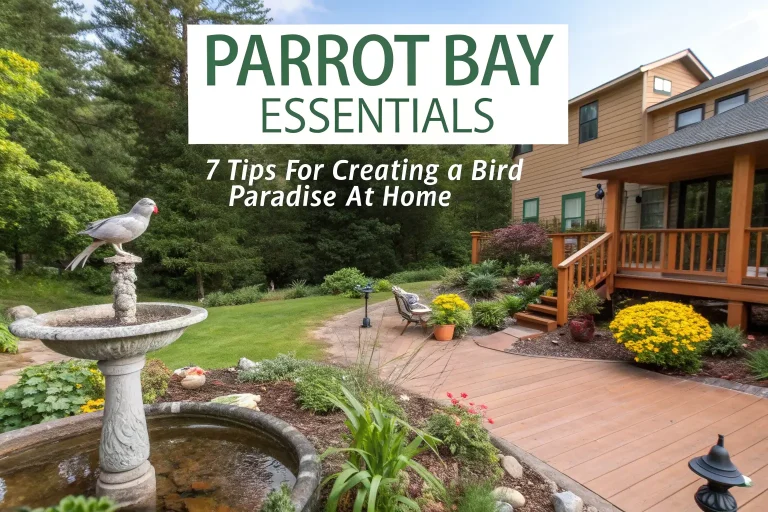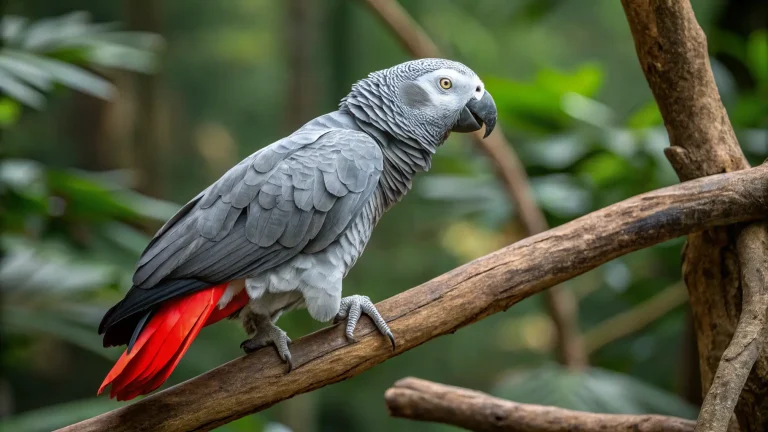Macaw Parrot Price: 7 Tips to Budget for Your Feathered Friend
Are you dreaming of bringing home a beautiful macaw parrot but worried about the macaw parrot price? You’re not alone. These magnificent birds, with their vibrant plumage and charismatic personalities, represent a significant investment that extends far beyond the initial purchase price. Understanding the true cost of macaw ownership is crucial for providing the quality care these intelligent creatures deserve.
Whether you’re eyeing a striking Blue and Gold Macaw or a rare Hyacinth Macaw, knowing how to budget properly will ensure both you and your future feathered companion can enjoy a harmonious life together. In this comprehensive guide, I’ll walk you through everything you need to know about macaw parrot prices and share seven practical tips to help you prepare financially for this colorful addition to your family.
Introduction
Macaws stand as nature’s masterpieces within the parrot world—vibrant living rainbows capable of forming deep bonds with their human caretakers. These spectacular birds aren’t just pets; they’re intelligent companions that can share your life for decades, sometimes even outliving their owners with lifespans reaching 50+ years.
The decision to bring a macaw into your home represents a major life commitment, comparable to adopting a perpetual toddler with wings, a bolt cutter for a beak, and the vocal power to wake the neighborhood. Understanding the financial commitment is just as important as appreciating their beauty and personality.
Did you know that some macaw species can memorize hundreds of words and even use them in context? Their intelligence rivals that of a 5-7 year old child, making them extraordinary companions—but this remarkable cognitive ability also requires significant financial resources to keep them properly stimulated and cared for throughout their long lives.
Species Overview
Scientific Name
Macaws belong to the family Psittacidae, with various species spanning several genera including Ara, Anodorhynchus, Cyanopsitta, Primolius, Orthopsittaca, and Diopsittaca. The most popular pet macaws typically come from the Ara genus, including the Blue and Gold Macaw (Ara ararauna) and Scarlet Macaw (Ara macao).
Physical Characteristics
Macaws are among the largest parrots in the world, with lengths ranging from 20 inches (Mini Macaws) to over 40 inches (Hyacinth Macaws) from beak to tail tip. Their most striking feature is their vibrant plumage, which can include brilliant blues, reds, greens, yellows, and oranges arranged in spectacular patterns.
These birds possess powerful hooked beaks capable of cracking nuts and seeds with ease. Most species display bare facial patches with tiny feathers arranged in unique patterns that may serve as “fingerprints” for individual identification. Their long, graceful tails can make up nearly half their total body length.
Subspecies
The macaw family includes approximately 17 species with various subspecies. Some of the most popular pet macaws include:
- Blue and Gold Macaw: Among the most popular and more affordable options ($1,000-$2,500)
- Scarlet Macaw: Known for vibrant red coloration ($2,000-$4,000)
- Green-winged Macaw: Slightly larger with deeper red plumage ($3,000-$4,000)
- Hyacinth Macaw: The largest and most expensive macaw ($15,000-$40,000)
- Military Macaw: Medium-sized with primarily green feathers ($2,000-$3,000)
- Severe Macaw: Smaller “mini macaw” option ($1,000-$2,000)
The macaw parrot price varies dramatically based on species, with the endangered Hyacinth Macaw commanding the highest prices on the market.
Habitat and Distribution
Natural Habitat
In the wild, macaws thrive in the lush tropical rainforests of Central and South America. These birds typically inhabit the forest canopy, where they navigate expertly through dense foliage and soar above the treetops. Different species have adapted to various ecosystems, from humid lowland forests to mountainous regions and even savanna-like habitats.
Geographic Range
Macaws are native exclusively to the Neotropical region, spanning from Mexico south through Central America and into South America. The highest concentration of macaw species occurs in the Amazon Basin, particularly in countries like Brazil, Peru, Bolivia, and Colombia. Sadly, their range has diminished significantly due to deforestation and illegal pet trade.
Adaptations
These magnificent birds have evolved several adaptations that allow them to thrive in their natural environments. Their zygodactyl feet (with two toes facing forward and two backward) provide excellent grip for navigating branches and manipulating food. Their powerful beaks have evolved to crack tough nuts and seeds that other animals cannot access.
In captivity, these adaptations mean macaws need substantial space, robust perches, and durable toys—all factors contributing to the ongoing macaw parrot price of ownership.
Diet and Feeding Habits
What It Eats
Wild macaws maintain a diverse diet consisting primarily of fruits, nuts, seeds, berries, leaf buds, and occasional insects. They seek out mineral-rich clay licks to counteract toxins in some of the seeds and fruits they consume.
For pet macaws, maintaining this dietary diversity is critical—and costly. A proper diet includes:
- High-quality commercial pellets ($20-50/month)
- Fresh organic fruits and vegetables ($50-100/month)
- Nuts and specialized treats ($30-50/month)
- Nutritional supplements ($15-30/month)
Foraging Behavior
In their natural habitat, macaws can fly over 15 miles daily searching for food. They use their powerful beaks to crack hard palm nuts and access seeds that other animals cannot reach. This foraging instinct remains strong in captivity, necessitating puzzle toys and foraging devices that add to the ongoing macaw parrot price.
Dietary Needs
Captive macaws require carefully balanced nutrition to prevent deficiencies that can lead to costly health problems like feather plucking, liver disease, or metabolic bone disease. Many owners underestimate that feeding a macaw properly can cost $100-200 monthly—an expense that continues for decades.
Behavior and Social Structure
Social Behavior
Macaws are highly social birds that typically mate for life and travel in family groups or larger flocks in the wild. This social nature translates to their captive environment, where they form intense bonds with their human caregivers.
This social requirement means macaws should never be left alone for extended periods. Many owners end up hiring pet sitters ($20-30/day) when traveling or investing in a second bird ($1,000-15,000 additional) to provide companionship.
Communication
These intelligent birds are renowned for their vocal abilities. Beyond their ear-piercing screeches (which can exceed 105 decibels), many macaws can learn to speak dozens or even hundreds of words. They communicate through body language, vocalizations, and feather displays.
Their loud nature means potential macaw owners should consider potential costs like soundproofing or even having to move to more suitable housing if neighbors complain about noise.
Mating and Reproduction
In the wild, macaws form monogamous pairs that often mate for life. They nest in tree cavities, raising typically 1-3 chicks per clutch. Breeding macaws requires specialized knowledge, equipment, and veterinary care—representing another significant cost for breeders that ultimately factors into the macaw parrot price for purchasers.
Conservation Status
Endangerment Level
Many macaw species face serious conservation challenges. According to the International Union for Conservation of Nature (IUCN):
- The Hyacinth Macaw is listed as Vulnerable
- The Blue-throated Macaw is Critically Endangered
- The Great Green Macaw is Endangered
- The Scarlet Macaw is classified as Least Concern but declining in many regions
These conservation statuses directly impact the macaw parrot price, with endangered species commanding significantly higher prices due to breeding restrictions and limited availability.
Threats
Wild macaw populations face numerous threats, including:
- Habitat destruction through deforestation
- Illegal trapping for the pet trade
- Climate change affecting food availability
- Competition for nesting sites
Conservation Efforts
Several organizations are working to protect wild macaw populations through habitat preservation, breeding programs, and anti-poaching efforts. Reputable breeders often contribute to these conservation programs—another factor influencing the macaw parrot price.
When purchasing a macaw, working with breeders who prioritize ethical practices and conservation is essential, even if it means paying a premium.
7 Tips to Budget for Your Macaw Parrot Price

1. Research Initial Purchase Costs Thoroughly
The upfront macaw parrot price varies dramatically by species:
- Mini Macaws (Severe, Illiger’s): $1,000-$2,000
- Blue and Gold Macaws: $1,000-$2,500
- Military or Scarlet Macaws: $2,000-$4,000
- Green-winged Macaws: $3,000-$4,000
- Hyacinth Macaws: $15,000-$40,000
Budget Tip: Consider adopting a rescue macaw. Many birds need rehoming, often at a fraction of the initial buying price, though they may require extra patience and training. Contact specialized parrot rescues in your area or monitor adoption websites.
2. Calculate Complete Housing Requirements
Macaws need substantial housing that allows for wing-stretching and movement:
- Minimum cage size: 36″W × 24″D × 48″H ($500-1,500)
- High-end aviary or custom cage: $2,000-5,000
- Placement perches and play stands: $200-500
- Cage accessories: $200-300
- Replacement parts: $100-200 annually
Budget Tip: Look for used cages from reputable sources, but never skimp on cage size. A secondhand premium cage in good condition can save 50-70% off retail prices while providing better housing than a new but inadequate cage.
3. Plan for Ongoing Nutritional Expenses
A balanced diet is non-negotiable for macaw health:
- Premium pellets: $20-50 monthly
- Fresh produce: $50-100 monthly
- Nuts and specialized treats: $30-50 monthly
- Supplements: $15-30 monthly
- Total annual food cost: $1,400-2,800
Budget Tip: Buy pellets in bulk during sales and freeze suitable fruits and vegetables when in season. Join wholesale clubs or subscribe to automatic deliveries for additional discounts on regular purchases.
4. Budget for Proper Veterinary Care
Specialized avian veterinary care is essential but expensive:
- Initial wellness exam: $100-200
- Annual checkups: $100-200
- Emergency fund: Minimum $1,000-2,000
- Common tests (bloodwork, fecal): $200-400
- Potential surgical procedures: $500-5,000
Budget Tip: Research avian pet insurance options ($20-40 monthly) or establish an automatic monthly transfer to a dedicated “macaw medical fund” savings account. Starting this fund before bringing your bird home gives you a financial cushion for any unexpected issues.
5. Anticipate Environmental Enrichment Costs
Mental stimulation prevents destructive behaviors and health problems:
- Durable toys: $100-200 initially, $50-100 monthly for replacements
- Foraging devices: $50-150
- Training tools: $50-100
- Annual enrichment budget: $600-1,500
Budget Tip: Learn to make DIY macaw toys using safe materials like untreated wood, stainless steel parts, and natural fibers. Join parrot owner groups to exchange toy ideas and even participate in toy exchanges to provide variety without the full retail cost.
6. Consider Long-term Time and Financial Commitment
The true macaw parrot price extends across decades:
- Potential lifespan: 50+ years
- Lifetime basic care costs: $100,000-200,000
- Estate planning considerations: Necessary for these long-lived birds
Budget Tip: Establish a “bird trust” with your estate planning to ensure your macaw will receive proper care should they outlive you. Some avian sanctuaries offer prepaid lifetime care programs for a one-time donation that’s considerably less than the lifetime cost of care.
7. Factor in Hidden and Unexpected Costs
Many first-time owners underestimate these expenses:
- Home modifications: Damage repair, bird-proofing ($500-2,000)
- Utility increases: Higher electric bills from additional lighting and temperature control ($20-40 monthly)
- Professional cleaning: Removing dander from HVAC systems ($200-400 annually)
- Travel/boarding costs: Pet sitters or boarding facilities ($30-75 daily when traveling)
- Training classes or behavioral consultations: ($75-150/session)
Budget Tip: Develop bird-sitting exchanges with other trusted macaw owners to reduce boarding costs when traveling. Install washable wall coverings in bird areas to make cleaning easier and less expensive over time.
Interesting Facts
The Hyacinth Macaw has the strongest beak among parrots, capable of exerting over 200 pounds of pressure per square inch—enough to crack coconuts and macadamia nuts with ease.
Macaws use their bright coloration as camouflage in tropical forests, where their plumage blends with colorful fruits and flowers when viewed from a distance.
These birds possess ultraviolet vision, seeing colors beyond human perception. Their feathers contain fluorescent pigments that likely play a role in mate selection.
A macaw’s tongue has a bone inside it, giving them exceptional dexterity for manipulating food and objects.
Some indigenous Amazon tribes traditionally used macaw feathers for ceremonial headdresses and believed these birds carried messages between humans and the spirit world.
Tips for Caring for Your Macaw
Beyond budgeting for the macaw parrot price, proper care includes:
- Daily interaction: Minimum 2-4 hours of direct attention
- Consistent routine: Regular sleeping schedule (10-12 hours of darkness)
- Training fundamentals: Step-up commands, recall training, and proper handling techniques
- Environmental considerations: Bird-safe cleaning products, avoiding Teflon cookware (toxic to birds), and eliminating exposure to cigarette smoke
- Health monitoring: Regular weighing, checking droppings, and observing behavior changes
Macaws thrive with positive reinforcement training and quickly learn undesirable behaviors if mishandled. Investment in professional training sessions can prevent costly behavioral problems later.
Role in the Ecosystem
Ecological Importance
In their native habitats, macaws serve as crucial seed dispersers, helping to maintain forest diversity. They consume fruits and excrete seeds far from parent trees, aiding in forest regeneration. Some plants have co-evolved with macaws, producing seeds that only germinate after passing through a macaw’s digestive system.
Macaws also create nest cavities that, once abandoned, provide shelter for other wildlife species, contributing to ecosystem biodiversity.
Impact of Decline
The declining wild macaw populations threaten forest health. Without these birds:
- Certain plant species lose their primary seed dispersal mechanism
- Forest regeneration rates slow
- Specialized relationships between plants and these birds unravel
This ecological importance is another reason why the premium macaw parrot price for ethically sourced birds is justified—it helps support conservation efforts preserving their wild counterparts.
Conclusion
When considering the macaw parrot price, remember that the initial purchase cost represents just a fraction of the lifetime commitment. These intelligent, stunning birds require substantial financial resources for proper housing, nutrition, enrichment, and veterinary care throughout their decades-long lives.
By implementing the seven budgeting tips outlined in this guide, you can prepare financially for macaw ownership and provide the quality of care these majestic birds deserve. Remember that compromising on essentials like cage size, diet quality, or veterinary care will ultimately cost more in the long run through health problems and shortened lifespan.
If you’re ready for the commitment, both financial and emotional, a well-cared-for macaw offers unparalleled companionship and brings vibrant joy to your home for many years. Consider reaching out to local bird clubs or sanctuaries to spend time with macaws before making your final decision—experiencing their personalities firsthand is invaluable in determining if these magnificent creatures are right for your lifestyle and budget.
Frequently Asked Questions
What is the cheapest macaw species to purchase?
The Hahn’s Macaw (also called Red-shouldered Macaw) and Severe Macaw are among the most affordable, typically ranging from $1,000-$2,000. However, remember that initial purchase price is a small fraction of lifetime care costs.
Why are Hyacinth Macaws so expensive compared to other macaws?
Hyacinth Macaws command premium prices ($15,000-$40,000) due to their endangered status, restricted breeding, incredible size and beauty, specialized care requirements, and limited availability. Their breeding success rate is also lower than other macaw species.
Are macaws more expensive to keep than smaller parrots?
Yes, significantly. Macaws require larger cages, consume more food, destroy toys more quickly, and may have higher veterinary costs due to their size. Yearly maintenance costs for a macaw typically run $2,000-$3,000 compared to $1,000-$1,500 for smaller parrots.
Can I find macaws for cheaper prices online?
While you may see lower prices online, extreme caution is warranted. Suspiciously low-priced macaws often come from questionable sources, may have health or behavioral issues, or could even be illegally imported. The savings rarely justify the risks and potential additional costs from resulting problems.
Do macaws require special insurance?
Standard home insurance typically doesn’t cover exotic pets like macaws. Specialized exotic pet insurance is available, costing $20-40 monthly depending on coverage. Many owners instead maintain dedicated emergency savings funds for their birds.
How much should I budget for unexpected macaw expenses?
A minimum emergency fund of $1,000-$2,000 is recommended for immediate veterinary needs. Long-term owners suggest setting aside 25-30% above your calculated annual expenses to cover unexpected costs like replacement equipment, medical emergencies, or specialized services.
Is adopting a rescue macaw more economical than buying one?
Initial costs are typically lower for adopted birds ($500-1,000 adoption fees versus $1,000-$15,000+ purchase prices), but rescued macaws may have health or behavioral issues requiring specialized attention and resources. The best motivation for adoption should be giving a deserving bird a second chance, not primarily cost savings.




